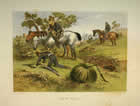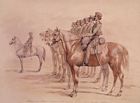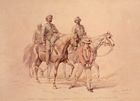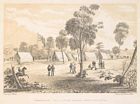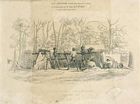From 1837, the colonial authorities in the Port Phillip District made several attempts to form a corps of Indigenous mounted troopers. It was thought that a Native Police corps would play an important role helping to uphold British law and order in the colony, on the part of its Indigenous and non-Indigenous inhabitants. Recruiting Aboriginal men to the corps was another way of ‘civilising’ the Indigenous population.
It would seem that those who joined the Native Police did so largely for pragmatic reasons, to form alliances with the colonists, as well as to obtain rations to help support the troopers’ extended families.
From 1842 to 1852, the Commandant of the Native Police corps was Henry E. Pulteney Dana. His troopers were based at Nerre Nerre Warren. The Native Police had a variety of duties to perform, including policing violence on the frontier, helping track people lost in the bush, escorting travellers, and delivering mail across the colony.
From 1849 the Native Police played an important role in the story of the discovery of gold and the early days of government regulation of the Victorian diggings. In early 1849 (two years before the ‘official’ discovery of gold), the Native Police were dispatched to Daisy Hill to guard a site where gold had been discovered on crown land. A letter from the Crown Commissioner of Lands to Superintendent La Trobe records that the Native Police’s role was, somewhat ironically given the recent land-grabs by pastoralists in the region, to prevent any unauthorised occupation of Crown Lands.
Commandant Dana and his troops were the first show of government authority at the rush at Mt Alexander. They arrived in the third week of October 1851. The Native Police troopers also escorted the first pack-horse convoys that carried gold to Melbourne from the goldfields.
Like just about everything else in society, the Native Police corps itself was transformed by the goldrushes. Many troopers left the corps to work for settlers on pastoral stations, or took off for the diggings themselves. Those remaining in the Native Police during the early years of the goldrushes were given a new role maintaining law and order on the goldfields.
A key element of this was enforcing the unpopular government licence fees on miners, which were to become so important in Victoria’s history at Eureka in late 1854. Dana went to Ballarat on 20 September 1851, with a party of government officials to tell the hundreds of men there mining for gold that the government required diggers to obtain a licence. Not surprisingly, this announcement was not met with pleasure by the diggers. Dana reported to the Colonial Secretary that the first few men - who had evidently decided that resistance was useless - who paid up for their licences were ‘struck and pelted by a mob’ and but for the presence of the Native Police, they would have been seriously injured. Dana requested a larger detachment of Native Police be sent to Ballarat at once to control the many ‘turbulent ruffians’ who had gone to the goldfields.
Commandant Dana died on 24 November 1852, and his Native Police corps disbanded not long after – it would seem that the troopers’ loyalty was to Dana, not to the government. The creation of the Victoria Police force in 1853 also removed some of the need for the Native Police.
